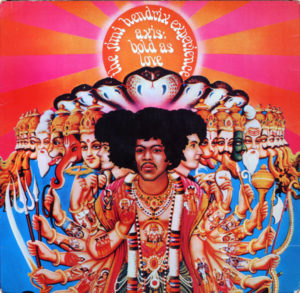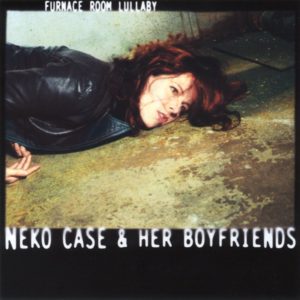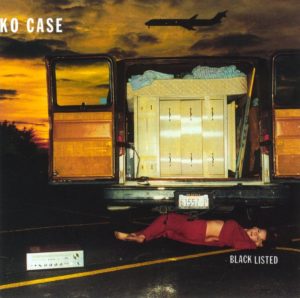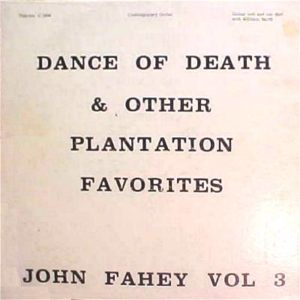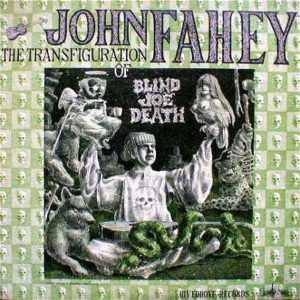Link to an article by Ismael Hossein-zadeh:
The Jimi Hendrix Experience – Axis: Bold as Love
The Jimi Hendrix Experience – Axis: Bold as Love Track 613 003 (1967)
Often considered the weakest of the three Jimi Hendrix Experience studio albums, I happen to like this best. The album has a refined but still straightforward and guileless sound, heavy at times, but with plenty of rock ballads too; melodic, with a hard psychedelic edge. The themes are a little more humble, perhaps, and even more equivocal than brash stuff like “Voodoo Child (Slight Return)” or “Foxy Lady.” Frankly, the studio experimentation of the follow-up Electric Ladyland obscures rather than augments what was best about Hendrix’s music in my opinion, and the eclecticism makes my attention wander. Hendrix was a great blues player, but sequencing lengthy blues tracks next to psychedelic rockers doesn’t work for me. Thankfully this album sidesteps much of that. There are no blues tracks here to grind the pace of the album to a halt. As a result this has more intimacy. Also, there is a mysticism and spirituality that binds most of the material together nicely. Before release, some of the master tapes were lost and had to be recreated from secondary sources (early takes dubbed to other media), which might have been a plus or minus, or both. This may not have as many well-known individual songs as other Hendrix albums — though it does have “Little Wing” and “Spanish Castle Magic.” But as a whole this is probably the most listenable front to back — the awesome debut Are You Experienced comes in right behind it though.
Neko Case & Her Boyfriends – Furnace Room Lullaby
Neko Case & Her Boyfriends – Furnace Room Lullaby Bloodshot BS 050 (2000)
Neko Case & Her Boyfriends’ second album Furnace Room Lullaby is a calculated take on country music that manages to be more than the sum of its parts. This is a real country album. But it only arrives at the realness of country music in a circuitous, even backwards way.
The album consciously stakes out a range encompassing crafted ballads (“South Tacoma Way,” “Porchlight”), sly waltz (“Thrice All American”), driving rockabilly (“Whip the Blankets,” “Mood to Burn Bridges”) and hazy lounge jazz (“No Need to Cry”). The album limps most of the way, with a kind of contrived indie rock vision of what country music is supposed to sound like, complete with all the clichés. That is the best part!
All sorts of country affectations are employed across the album, like slide guitar and fiddle, but most notably the rock-styled rhythms from the drums and Case’s countrified vocals that sound nothing like those of a southerner. She has a distinctive way of singing sustained, crescendo-ed notes in a dramatic way, often book-ended by clipped phrases with half-yodeled melisma, and also frequently bolstered with washes of legato keyboards or backing vocals. Yet, the album succeeds precisely because the illusion of authenticity fails. No matter what urban mannerism she laces through her country songs — the essence of insurgent (alt) country is using the devices of country music usually directed to rural audiences to appeal to urban middle-class audiences — something persists that seems to cut through those very mannerism. It is somewhat of a frequent occurrence that “rock” musicians make country music to tap into its supposed authenticity, at least implying that authenticity is lacking in rock music, but Furnace Room Lullaby preempts that by its obviously artificial performances. And, really, country music is a set of arbitrary and therefore artificial devices just as much as rock music. What emerges then is something else, an existential denial of all authenticity and a kind of triumph of crafted artifice that builds up an approximation of the idea of authenticity through non-authentic means. Is Case then simply pretending to be what she really is? This is a really intriguing way of staging what are songs — all excellent compositions mind you — mostly about personal identity forged in the crucibles of relationships, a hometown, and a trajectory of subtle but undeniable ambition. The underlying question that looms across the entire album is, “Who am I?” Case never ventures an affirmative answer, but keeps pondering that question over and over again.
Neko forges music from her Pacific Northwest roots with a cautious nostalgia. “South Tacoma Way” is the album’s epic story of loss. Of course themes of heartache and resignation come up is every song; some call it “country noir”. These songs make your problems seem either easier or shared. The highlight of the album may well be “Thrice All American,” about the city of Tacoma, Washington, Case’s adopted hometown and winner of the All-America City Award three times — but the song is also a waltz.
Neko Case & Her Boyfriends manage to combine all kinds of influences. It all works. At this stage of her career, before fully succumbing to the banality of indie rock, Neko was as brave as any singer-songwriter out there (though most of these songs were written with collaborators). She was okay with being a little like her heroines — Poison Ivy from The Cramps, etc. On “Guided By Wire” she tells of “those who’re singin’ my life back to me.” It is that binding of her identity to those who (circularly) give her meaning that raise the stakes here. There really is no “true” identity, just tentative links to people and places, many of them commonplace. Country music at its best always made that same point.
Recommended.
Neko Case – Blacklisted
Neko Case – Blacklisted Bloodshot BS 099 (2002)
Blacklisted is a dark album. It’s was a new direction Case is heading into, and she knew it. The loneliness of this new position is evident. There isn’t much musical idolatry here, though she keeps one eye fixed on the past. Her stories chronicle things witnesses and remembered, observed tidbits pulled together to form the songs.
Neko Case has changed quite a bit since Furnace Room Lullaby. Her songwriting is that much more isolated. Her sense of humor scarcely surfaces. A weariness seems to have taken hold long before the songs took shape. Now a passion for something timeless is her calling card.
The songs are a mixture of jagged lyrics and smooth sounds, with lyrics so ragged and blunt that listeners come away bruised. Case has moved into somewhat more traditional country arrangements performed with small, eclectic combos. Her lyrics, however, stand opposed to traditional subjects. Blacklisted eschews “heartbroken woman” themes. Her best outings, “Wish I Was the Moon” and “Ghost Writing” among them, are deeply personal. Yet even at her most confessional, her songs remain framed in the Americana she adores. This isn’t a new way to write music, but it’s a fresh approach for Neko. While still one to romanticize the ways of lonely scoundrels, she employs a different kind of drama than in the past. Of course, honesty isn’t always the best policy. The truth can border the mundane. So there’s a danger built into her craft. It would be nice to say she has the situation under control at all times. That isn’t the case. But it’s better to have Neko overexposed on record than obscured.
On Blacklisted, Neko’s delivery doesn’t have much immediacy. Still, she is reaching. But for what? Unfortunately this was the first step towards capitulation to the mundane and banal aspects of indie rock that would garner her more commercial success over the next 5-10 years. This one is medicore at best, and pales in comparison to Furnace Room Lullaby.
Daniel Kovalik – Samantha Power, Henry Kissinger & Imperial Delusions
Link to an article by Daniel Kovalik:
Andrew Cockburn – The Pentagon’s Real $trategy
Link to an article by Andrew Cockburn:
Daniel Raventós & Julie Wark – Basic Income: The Silence in the Noise
Link to an article by Daniel Raventós & Julie Wark:
“Basic Income: The Silence in the Noise”
Bonus links: “Basic Income, Basic Issues” and “The Argument Against Basic Income” (note that this critique assumes there is no intent to move beyond capitalism behind a BIG, and that private ownership of the means of production should remain dominant; but the technical point that a basic income could be completely undermined by inflation under that assumption is significant).
Noam Chomsky on the Breakdown of American Society and a World in Transition
Link to an interview with Noam Chomsky by C.J. Polychroniou:
“Noam Chomsky on the Breakdown of American Society and a World in Transition”
Bonus link: “Worthington’s Law”
John Fahey – Vol 3: Dance of Death & Other Plantation Favorites
John Fahey – Vol 3: Dance of Death & Other Plantation Favorites Takoma C 1004 (1965)
As a guitarist John Fahey’s talents grew quickly in the early 1960s. Vol 3: Dance of Death & Other Plantation Favorites was definitely his most accomplished album to date (though later re-recordings of his first two albums are just as good). He was still operating in reach of the traditional blues, folk and country material he drew from. Excursions into the realm of tape manipulation, field recording overdubs, and experimental guitar techniques still lay in the future. But his trademark ability to take traditional forms and re-purpose them into something a little darker and more existential — by way of trying to play a “symphony” on a single steel string acoustic guitar — coalesced here. Surely one of the man’s best efforts. Worthy of plenty of spins.
John Fahey – The Transfiguration of Blind Joe Death
John Fahey – The Transfiguration of Blind Joe Death Riverboat RB-1 (1965)
By the time he recorded The Transfiguration of Blind Joe Death, John Fahey was beginning to experiment. He was drawing in influence not just from country, blues and folk, but also Euro-classical and Indian classical traditions. What holds this album back from being great is that he’s going in too many different directions. He doesn’t quit fit everything together as seamlessly as he would later on The Yellow Princess or in as sweeping and epic a way as on America, and for that matter the experiments are a bit more tepid than on the likes of Guitar Vol. 4 (The Great San Bernardino Birthday Party and Other Excursions), which is admittedly a bit uneven. Fahey admirers will nonetheless dig this, and it still holds the potential to open a few eyes and ears for the unconverted too. If you have the option, though, head for The Yellow Princess and America first to hear the ideas here more fully realized.

